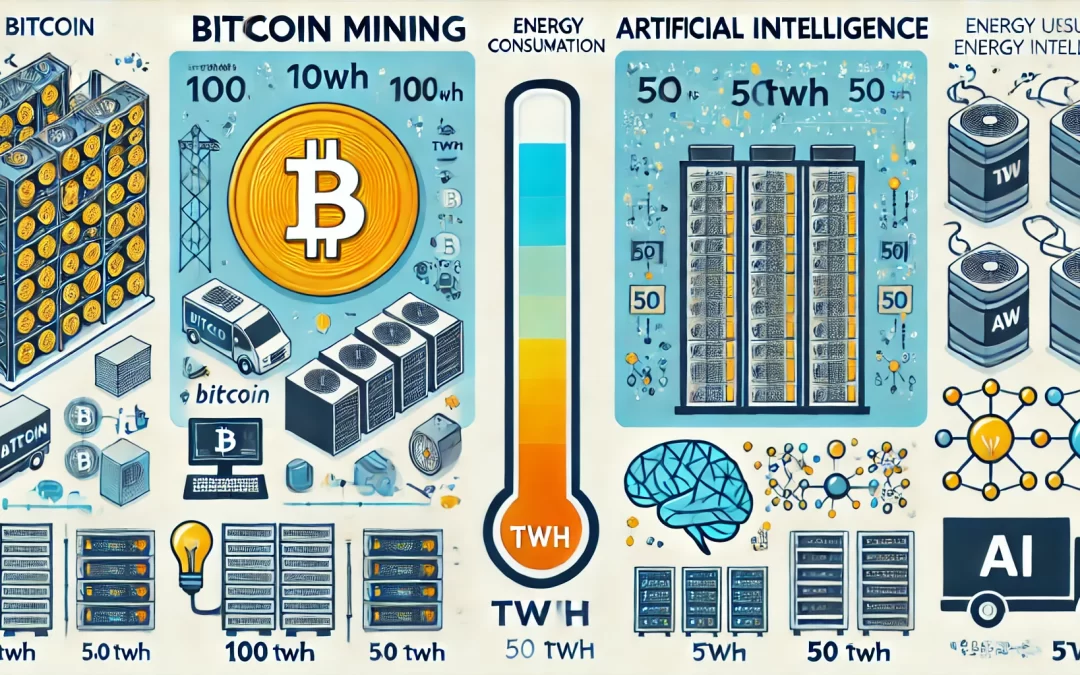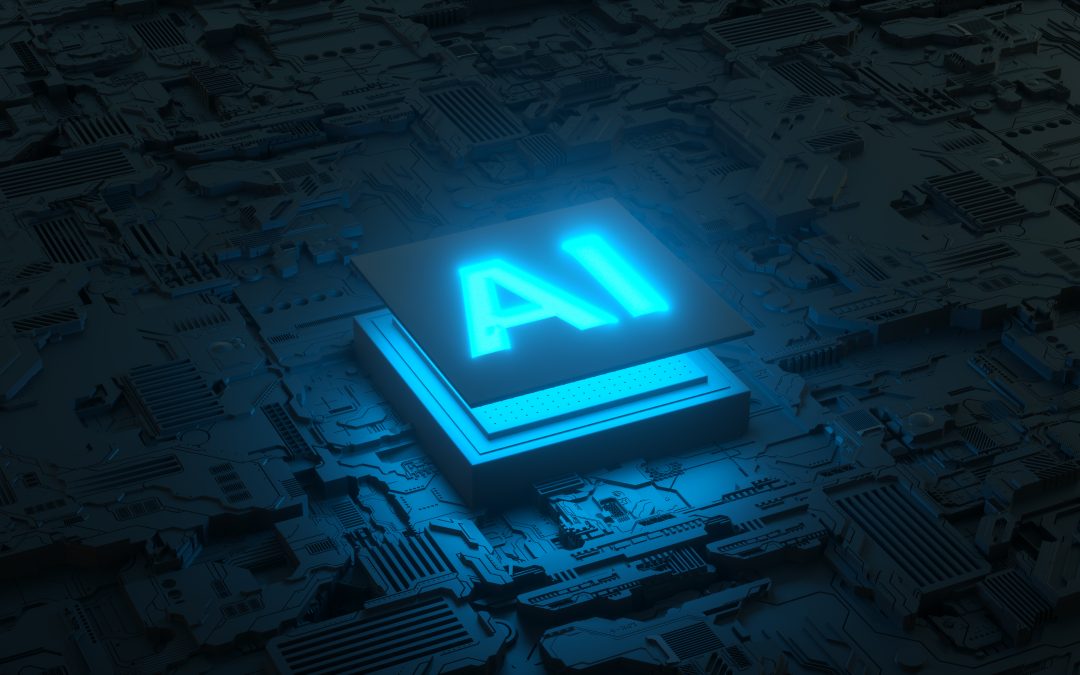
by Mark | Jun 20, 2024 | AI and Machine Learning, Industry News
The image above was created by the ChatGPT Image Generator by searching the phrase “Please create a graphic that shows the difference in energy usage between bitcoin and artificial intelligence.” The image features a Bitcoin mining setup on one side and an AI setup on the other, with a balance scale in the center comparing their energy usage. The background includes tech-related graphics and symbols representing both Bitcoin and AI.
Bitcoin and AI are two of the most transformative forces right now in the world of technology, and we at Web Professionals Global are closely following them and what they mean for the future of our profession. Both bitcoin and AI have significant implications for the future of industries and societies worldwide. However, alongside their promise comes a growing concern surrounding the substantial energy consumption required to power these technologies. Today we are taking a look at the energy dynamics of Bitcoin and AI, comparing their consumption patterns, impacts, and the ongoing debate surrounding their sustainability. Readers may remember a similar article we published in October of last year. In less than a year, energy usage and future usage estimates have increased significantly.
Understanding Bitcoin’s Energy Consumption
Bitcoin operates on a decentralized ledger technology known as blockchain. The process of validating transactions and adding them to the blockchain network, known as mining, is integral to its operation. Bitcoin miners compete to solve complex mathematical puzzles, requiring substantial computational power. This mining process, essential for maintaining the integrity and security of the network, consumes a staggering amount of energy.
The primary driver of Bitcoin’s energy consumption is the Proof of Work (PoW) consensus mechanism. PoW involves miners using specialized hardware to solve cryptographic puzzles, a process that demands immense computational resources. As more miners participate and the network grows, so does the difficulty of these puzzles, leading to increased energy consumption. In fact, the Cambridge Bitcoin Electricity Consumption Index estimates that Bitcoin consumes 112.31 TWh (terawatt-hour) annually. This equals the entire energy consumption of some countries around the world.
Critics argue that Bitcoin’s energy footprint is unsustainable, citing its environmental impact due to reliance on fossil fuels and the potential strain on global energy resources. The decentralized nature of Bitcoin means that anyone with adequate hardware and electricity can participate in mining, creating a competitive race that further escalates energy demands.
The Environmental Debate
The environmental implications of Bitcoin’s energy consumption have sparked intense debate. Proponents argue that Bitcoin incentivizes the development of renewable energy sources, as miners seek cheaper and more sustainable power options to maximize profits. However, detractors point to the current predominance of non-renewable energy sources in Bitcoin mining, particularly in regions with low electricity costs driven by coal and other fossil fuels.
Recent years have seen efforts within the Bitcoin community to promote sustainability. Initiatives such as the Bitcoin Mining Council aim to improve transparency and advocate for the use of renewable energy in mining operations. Additionally, advancements in mining hardware efficiency and the exploration of alternative consensus mechanisms, such as Proof of Stake (PoS), could potentially mitigate Bitcoin’s energy intensity in the future.
AI: Energy Consumption and Computational Needs
Artificial Intelligence, encompassing machine learning (ML) and deep learning (DL), represents another frontier in technological innovation. AI algorithms analyze vast amounts of data to derive insights, powering applications ranging from natural language processing to autonomous vehicles. Like Bitcoin, AI’s advancement relies heavily on computational power, albeit through different mechanisms. The semiconductor analysis firm SemiAnalysis estimates that if Google were to use ChatGPT for every Google search it would require 29.2 terawatt hours (TWh) of annual consumption.
AI’s energy consumption primarily stems from training deep neural networks. Training involves feeding algorithms with enormous datasets and iteratively adjusting model parameters to optimize performance. This iterative process demands significant computational resources, often requiring specialized hardware such as Graphics Processing Units (GPUs) and increasingly, dedicated AI chips.
While training consumes substantial energy, the deployment phase—where AI models make predictions or decisions in real-time—typically requires less power. This distinction highlights the evolving nature of AI energy consumption throughout its lifecycle, from initial development and training to ongoing operational use.
Comparing Energy Intensities
Quantifying the energy consumption of Bitcoin versus AI involves nuanced considerations. Bitcoin’s consumption is continuous and primarily driven by the mining process, which operates 24/7 across global networks. In contrast, AI’s energy use fluctuates based on demand for training and inference tasks, which can vary widely depending on the application and scale of deployment.
Recent studies have attempted to benchmark these technologies’ energy footprints. While direct comparisons can be challenging due to their disparate operational mechanics, some analyses suggest that AI, particularly during intensive training phases, can rival or exceed Bitcoin’s energy intensity over similar periods. However, AI’s energy demands can vary significantly depending on factors such as model complexity, dataset size, and hardware efficiency.
Towards Sustainability and Efficiency
Both Bitcoin and AI face scrutiny regarding their environmental impact and sustainability. In response, stakeholders across industries are exploring avenues to enhance efficiency and reduce energy footprints.
For Bitcoin, innovations in mining hardware and shifts towards renewable energy sources hold promise. Efforts to promote transparency and accountability within the mining community aim to mitigate environmental concerns while ensuring the network’s robustness and security.
Similarly, AI researchers and practitioners are exploring avenues to optimize algorithms and hardware architectures for energy efficiency. Techniques such as model pruning, quantization, and federated learning aim to reduce computational demands without compromising performance. Moreover, advancements in AI hardware, including the development of more energy-efficient processors, contribute to sustainability goals.
Balancing Innovation and Sustainability
As Bitcoin and AI continue to evolve, so too will the discourse surrounding their energy consumption. The imperative to balance technological innovation with environmental sustainability remains critical. Stakeholders must collaborate to foster responsible practices, leverage renewable energy solutions, and advance energy-efficient technologies.
While challenges persist, the potential benefits of Bitcoin and AI are undeniable. From financial inclusivity and decentralized finance (DeFi) enabled by Bitcoin to transformative advancements in healthcare, transportation, and beyond driven by AI, these technologies offer profound opportunities for global progress. How Bitcoin and AI will ultimately unfold remains to be seen, but the impact of both is already clear.
Research estimates that by 2025, the IT industry could use 20% of all electricity produced and emit up to 5.5% of the world’s carbon emissions. That’s more than most countries’ total emissions outside of the U.S., India and China. All of the computers, routers, smart devices and more that make up the internet use an enormous amount of energy. Additionally, as new technologies such as satellite internet expand coverage to areas that traditionally have struggled to get access, the amount of energy that the internet consumes will only continue to grow.
Wrap-Up
We welcome your comments and questions about this topic and the world of the web. Reach out today to find out more about our mission of “Community, Education and Certification.” We are always happy to have new web professionals join our ranks.

by Mark | Apr 30, 2024 | AI and Machine Learning, CSS3, Industry News, Web Accessibility, Web Design Trends, WWW Desktop View
As April is ending, I thought it would be a good time to review articles of interest which I have been reviewing this month (and articles members and colleagues have made me aware of). As readers know, web technologies are always evolving. This is that keeps me interested in all things web (and has for well over three decades).
Accessibility
New software has been developed to enable blind and low vision users to create interactive, accessible charts. The software is called Umwelt and was created by researchers at MIT and University College London. The software is designed for screen reader users.
AI
If you happen to own an iPhone (and it is newer than 5 years old with iOS 17), there are AI features available to you now. These include cinematic video editing (subject can be detected and focus can be changed depending on the action). You can also use the Live Text feature to copy text from images. Yes, this has been around for a while, but has been significantly improved. You can also create stickers from your own photos. Obviously a lot more is coming with IOS 18.
A recent study also revealed a surge in the use of AI to enhance video accessibility. Wistia’s State of Video report is summarized in the linked article. Interestingly, part of the study also found that shorter videos are not necessarily that much more engaging. We encourage you to read the summary and the full report.
CSS
This article on CSS trends for 2024 is most interesting. It is amazing how much continues to evolve with this technology. From new color systems to subgrids to cascade layers, there are many changes happening. Frameworks such as Tailwind CSS, Chakra UI also continue to evolve. Readers are encouraged to check out the above linked article.
Web Design trends
Here are some web design trends emerging in 2024. These include: denser, richer graphics, AI generated designs, micro interactions, kinetic typography and much more continue to evolve.
WordPress
Given that this technology supports roughly 38% of websites, we thought readers might want to know what is new for developers with the release of version 6.5. For those who do not know, the next version (6.6) will drop support for older versions of PHP (7.0 and 7.1). The WordPress Playground continues to evolve and some enhancements are discussed in this article as well.
Those are some of the articles we found interesting in the past month. We are curious what you found interesting as well. Please let us know in the comments.

by Mark | Mar 31, 2024 | AI and Machine Learning, CSS3, HTML5, JavaScript, State of the Web, Web Accessibility, Web Security, WWW Desktop View
Spring is officially here (in the northern hemisphere). A lot has been happening both in the organization and the world of web technologies. Readers of this blog know we are in the midst of helping many states with their SkillsUSA web design and development competitions. Winners at the state level are then eligible to compete at the national level in June (in Atlanta). We are glad to be helping these states.
For those who suspect, the featured image was created with AI (Adobe Firefly in this case). Readers of this blog will also recall that all links will open in a new browser tab.
Web Technology Updates
- Accessibility trends – we found this overview of 7 accessibility trends to watch in 2024 an interesting read. Web accessibility testing will become more automated with greater reliance on AI (Artificial Intelligence). Personalized accessibility solutions and more integration of voice technology also top the list. We encourage you to review the article to learn more about these trends.
- CSS – Chris Coyier created a bookmarkable guide to a list of recent enhancements to CSS. We like the overview of these along with notes about when you should care and what browsers support these capabilities now. Working examples (which allow you to also view the code) are highly useful and helpful. Emphasis is on container queries, the :has( ) pseudo selector, View transitions, anchor positioning, and much more. We encourage readers to review and reference his article.
- Frontend Trends – Diego Petrecolla provided a solid overview of frontend trends for early 2024. This includes a nice overview of BFF (Backend for the Frontend) patterns, PWA (Progressive Web Apps), JavaScript and more.
- Web Development Trends – We found this informative article useful as it combines an overview of where these technologies came from (HTML, CSS, JavaScript) along with where they are going (use of AI in web development, voice search optimization, Web Assembly, and cyber security measures). Definitely a lot to think about as we move into the second quarter of 2024.
- Web Design Trends – Christopher Lara reviews 24 web design trends (since it is 2024, after all). From scrolling animations to claymorphism to dark mode to frosted glass effects to voice activated interface, there is a lot to unpack in this article.
- Cybersecurity trends of 2024 – Vera Cooper (Splashtop) provides an overview of many cybersecurity trends which are emerging in 2024. AI and machine learning top her list. IoT is a close second. Phishing attacks, mobile security, and much more are discussed in her article as well.
These are some of the articles/ trends we are watching evolve in 2024. What additional trends do you see? Let us know in the comments. We always look forward to insights from our members.

by Mark | Dec 7, 2023 | AI and Machine Learning, CSS3, Industry News, JavaScript, Web Accessibility
As 2023 draws to a close, we thought it would be helpful to share some of the articles we have been reading. We have tried to focus on a handful of articles (covering the categories below). As we have noted on previous articles, all links will open in a new browser tab/ window.
Artificial Intelligence
As readers are well aware, the pace of change in AI is hard to fathom. This article summarizes what we should be looking for in late 2023 and early 2024. Perhaps we will look back at this article in mid-2024 and see how the predictions fared.
As you may suspect, the “featured image” accompanying this post was generated by Adobe Firefly.
Accessibility
Web Content Accessibility Guidelines (WCAG) 2.2 were released on October 5. There are many aspects to consider. We found Craig Abbott’s analysis most helpful (this is definitely worth a read).
CSS
If you are even a little curious where CSS might be heading, we encourage you to review Eric Meyer’s article concerning Nuclear Anchored Sidenotes. Of course, you will need a fairly recent version of the Chrome browser with the “experimental web features” option enabled if you want to try out his examples.
JavaScript
JavaScript continues to evolve as well. Here is a good article concerning new features for 2023 and expectations for 2024. Some of the main features discussed including the ability to change an array by copy without mutating the original array. One can also find within an array starting at the end and working backwards.
WordPress
WordCamp US concluded several months ago. However, these presentations provide an overview of many insights provided at this venue. Of course, the annual keynote address by Matt Mullenweg (State of the Word) is scheduled for December 11 (from Spain). We are definitely curious what will be covered in that keynote.
Feedback please!
It has been a few months since we have posted a “desktop view” article. Do you enjoy reading these articles? What other topics would you like to see us cover (to learn more about)? Please let us know in the comments.

by Steve Waddell | Oct 27, 2023 | AI and Machine Learning
This article was written by Daniel Foreman, a member of the Web Professionals Global Advisory Board. You can read more about Daniel here.
The image above was created by the ChatGPT Image Generator by searching the phrase “Environmental cost of AI.” The image depicts a robot holding cash standing next to a factory emitting smoke.
In the past couple of years, we’ve all become painfully aware of the environmental cost of cryptocurrency. The energy consumption of these digital currencies, driven by the massive demand for GPUs to mine coins, is equivalent to that of an entire nation. This is a major issue that we’ve had to grapple with.
Now, as we begin to emerge from a hectic 2023, we find ourselves in the midst of what can only be described as an AI war. Companies are vying for dominance in this new digital frontier, diverting vast amounts of computational resources to power the training of these services. The environmental implications are startlingly similar to those of cryptocurrency.
Analysts predict that the carbon footprint of AI could match, or even surpass, that of bitcoin mining – a sector that already generates more greenhouse gas emissions than some entire countries. If the AI industry continues on its current trajectory, it’s projected to consume a staggering 3.5% of the world’s energy supplies by 2030.
Consider this: one of the leading AI companies spends an estimated $700,000 per day – yes, per day – delivering its online service to 100 million users worldwide. And with the recent integration of Windows Copilot into Windows 11 as a default feature, this usage number is set to soar even higher.
According to the latest available data, ChatGPT currently has over 100 million users. And the website generated 1.6 billion visits in June 2023.
ChatGPT use increases during the school year. Website traffic jumped up nearly 5% from August 2023 to September 2023.
A survey by Savanta reveals that 47% of respondents have used ChatGPT for fun or learning purposes. Surprisingly, 42% of millennials use it for businesses, which is higher than 29% of Gen Z users, 26% of Gen X, and 20% of Boomers.
Both cryptocurrency mining and AI share a voracious appetite for high-end, powerful GPUs. This surge in AI activity has sent nVidia’s profits skyrocketing 101% since last year, reaching a whopping $13.5 billion dollars.
When an AI is deployed, it undergoes a training procedure that requires hundreds of hours of runtime before it even reaches the end user. It’s estimated that GPT-3, a relatively simple AI model and the predecessor of the current model GPT-4, consumed 1,287 megawatt hours of energy during training using 10,000 GPUs. This process produced as much CO2 as the equivalent of 123 gasoline-powered passenger vehicles driven for one year.
And let’s not forget about other language models like BLOOM and LLAMA, which have also consumed significant amounts of power during training. These three models alone have consumed enough energy to fly around the entire Earth 41.25 times.
Once these models have been trained and are up and running on a daily basis, every single query given to GPT-4 on Open.AI is estimated to consume the same amount of power as a 5 watt lightbulb running for 1 hour and 20 minutes.
If we take OpenAI’s 100 million users and assume each user makes one query every day, then that amount of energy used is 6.65W x 100,000,000 = 665 megawatts per day or 242 terawatts a year. To compare, most people spend about 10,000 kilojoules amount of energy per day or about constant of 110 watts for 24 hours.
Currently, it’s estimated that cryptocurrencies draw about 150 terawatts annually. If our estimate of one person making one query a day every day for a year holds true (which is just a guess), then OpenAI on its own is already consuming more power than cryptocurrency.
Additionally, major players in other countries, such as Baidu in China, have entered the AI realm.
This is a wake-up call for all of us. We need to be mindful of our digital consumption and strive for sustainable solutions in our pursuit of technological advancement.

by Mark | Aug 21, 2023 | AI and Machine Learning, Education
One of the hottest topics in technology currently is artificial intelligence (AI), which is seemingly poised to affect many aspects of our lives. One of these areas is education, as schools, teachers, parents and students grapple with how to best deploy and manage AI tools in the classroom. At Web Professional Global we have many secondary and post-secondary students in our ranks, so we keep a close eye on developments that affect our members. In this article we will take a look at some of the challenges associated with education and AI and solutions for moving forward.
Overview
The rise of tools like ChatGPT has far-reaching implications, and in many cases it provides students with a quick and convenient way to complete classwork. These AI tools can write and edit essays, summarize articles, and complete other homework assignments. This allows students to “pass” subjects without actually understanding the underlying materials. This leads to students feeling like they can go through life without actually putting in hard work and learning valuable skills.
However, teachers can also use AI tools to their advantage. AI can help provide answers to students who have questions about material and provide feedback on assignments. Schools that have leveraged AI have also found that students are often more inquisitive when it comes to asking AI questions as it eliminates the fear of “asking a dumb question” in front of peers. As we move forward, it will be important to utilize AI so that it helps teachers in the classroom. AI will never replace teachers, nor should it. Students will always need a caring adult to lead in the classroom. We never want to place an AI system between the student and teacher, as we have already seen how generations have been affected by technology.
Keep in mind that many AI application programming interfaces (APIs) take a fair amount of creative license when answering questions. While it may seem like an AI tool is speaking factually and with authority, it might be spinning the answer a bit to reflect, for example, the beliefs of the person who programmed it. Also, remember that many AI tools are limited in what information base they are working from. For example, at the time this article was written the ChatGPT’s data set covers only information prior to September 2021. This means if you asked it to tell you the features of the iPhone 14 it would tell you that it doesn’t exist:

Our Response
We need to recognize AI as a tool first and make it a tool. AI should be a help and not a replacement. As humans, we are purpose driven. We are happiest when we have a purpose and are striving toward a goal. Some may fall into the trap of just letting AI do everything for them, and in doing so they will be relinquishing their own humanity. The rest of us will see AI as a tool, like the smartphone. You can use it to help you navigate your busy life, or, as many do, you can become overly dependent on it. Our fervent hope is that once again humankind rises above AI technology, recognizes it for what it is and does not allow it to seduce us to become its subject.
We believe these challenges provide an opportunity for those in the education space, especially students, to commit (or re-commit) to ethical behavior in the classroom and when working on academic projects. Web Professionals Global is part of the content authenticity initiative with Adobe and we also have a Code of Ethics that non-members can sign. Secondary and post-secondary students who complete coursework and receive our certifications all must adhere to the Code of Ethics, which includes the following:
Being open and truthful: Although we cannot guarantee that all of the members of the Web Professionals Global community subscribe to this code of ethics, as a professional association we aspire to instill in our members and non-members alike the highest ethical standards.
Respecting and protecting intellectual property: As web professionals, it’s our responsibility to protect the intellectual property rights of others including personal data and all electronic media and files. As web professionals, we have a duty and a fiduciary responsibility to protect this integrity by adopting and implementing best practices of our customer’s data and to keep it secure.
Being responsive: As web professionals we owe it to our clients and stakeholders to respond to inquiries in a timely manner. Web Professionals Global members should be candid about their available response time and communicate that to customers in advance.
Utilizing written communications: As web professionals it is our responsibility to effectively communicate with our clients and stakeholders. When making a request of the customer, or when making promises, put them in writing. Despite our best efforts, disputes sometimes happen. Having a well-documented and agreed-upon relationship will serve both parties. This should include all conversations about who does what and when, work to be performed, timelines, cost and change orders.
Find Out More
Interested in hearing more about the ethics of AI and our work at Web Professionals Global? Contact us today.







